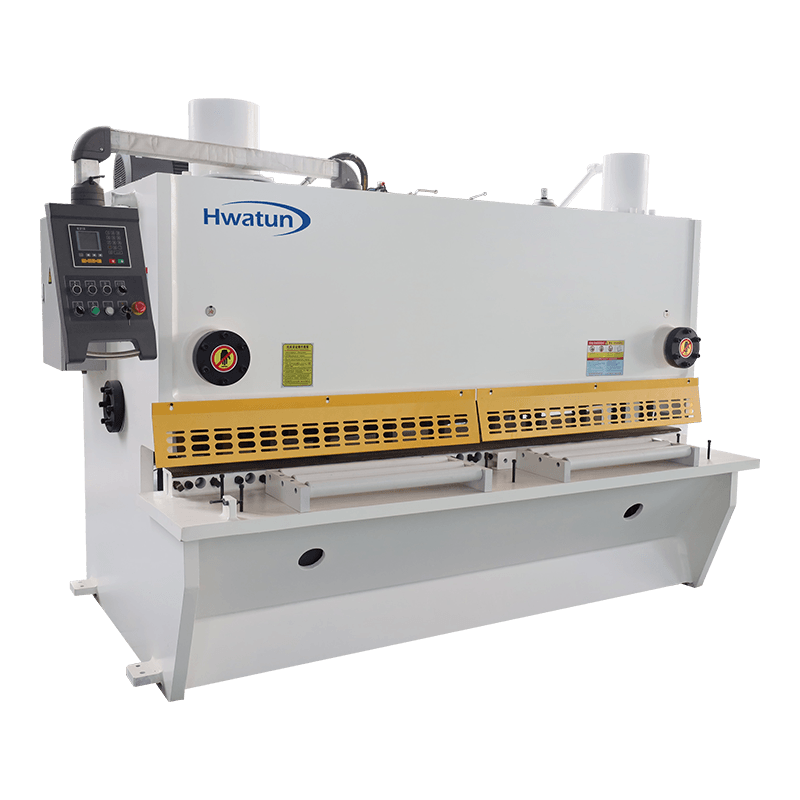Web Menu
Product Search
Exit Menu
How to choose a high-performance and efficient shearing machine according to processing requirements?
In the metal processing industry, shearing machines, as a basic and key equipment, are widely used in sheet metal processing, automobile manufacturing, shipbuilding, machinery manufacturing and other fields. Its main function is to shear metal sheets in a straight line according to the set size, and provide accurate blanks for subsequent stamping, bending, welding and other processes.
1. Clarify the type and thickness range of processed materials
Sheets of different materials and thicknesses have different requirements for the shearing force, blade gap and structural strength of the shearing machine:
Material type: Common ones include carbon steel, stainless steel, aluminum alloy, copper, etc., among which stainless steel and high-strength alloy steel plates require greater shearing force.
Material thickness: The nominal processing thickness of the general shearing machine refers to the maximum shearable thickness of Q235 steel. If harder materials are processed, the upper limit of the thickness should be appropriately reduced.
Sheet width: The shearing width determines the length of the machine's workbench, and it needs to be selected in combination with the commonly used sheet specifications in actual production.
It is recommended to refer to the shearing force curve provided by the manufacturer based on the performance parameters of commonly used materials to ensure that the selected equipment does not overload during long-term operation.
2. Determine the requirements for shearing accuracy and efficiency
For precision processing or batch production, shearing accuracy and efficiency are important indicators for measuring the performance of shearing machines:
Shearing accuracy: including shearing angle error, repeated positioning accuracy, etc. Usually, hydraulic CNC shearing machines have higher accuracy than ordinary mechanical shearing machines.
Shearing speed and frequency: The application of automatic feeding system and servo drive technology can significantly increase the number of shearing times per unit time, which is suitable for large-scale continuous operations.
Back gauge system: The use of CNC back gauge device can realize rapid adjustment of shearing length, reduce manual intervention, and improve processing consistency.
For production lines with a high degree of automation, it is recommended to use a shearing machine with a CNC control system, and consider the possibility of linkage integration with other equipment (such as laser cutting machine, bending machine).
3. Evaluate the structure and transmission mode of the shearing machine
The structural form of the shearing machine directly affects its stability, maintenance cost and service life:
Mechanical shearing machine vs hydraulic shearing machine:
Mechanical shearing machine relies on flywheel and clutch transmission, which is suitable for occasions with small shearing force and simple operation;
Hydraulic shearing machine is driven by oil cylinder, with stable shearing, low noise and flexible shearing force adjustment, which is more suitable for high-precision and heavy-load applications.
Gantry structure vs swing structure:
Gantry shearing machine has good rigidity and is suitable for thick plate shearing;
Swing shearing machine has adjustable shearing angle and higher shearing quality, which is suitable for fine processing of thin plates.
In addition, the overall casting process of the fuselage, the guide rail lubrication system, the blade material (such as Cr12MoV, high-speed steel), etc. are also key factors affecting the stability and durability of the equipment.
4. Pay attention to safety protection and maintenance convenience
A safe and efficient shearing machine must not only have good processing performance, but also be equipped with complete safety protection measures and convenient maintenance design:
Safety devices: such as light curtain protection, emergency stop button, two-hand start control system, etc., to prevent personal injury caused by misoperation.
Automatic lubrication system: can reduce the workload of daily maintenance and extend the service life of the equipment.
Convenience of replacement of wearing parts: such as whether the upper and lower blades, bearings, oil seals, etc. are easy to purchase and replace, which is related to the downtime and maintenance cost of the equipment.
Choosing a high-performance and high-efficiency shearing machine cannot be decided based on appearance or price alone, but should be comprehensively evaluated from multiple dimensions such as processing material characteristics, precision requirements, production efficiency, structural configuration, safety performance, and post-maintenance. Only shearing machines that match the actual production needs of enterprises can truly exert their effectiveness and bring higher production benefits and market competitiveness to enterprises.
News categories
Product categories
Related Products
 +86-159 5138 1316
+86-159 5138 1316 +86 180 6819 3096
+86 180 6819 3096 [email protected]
[email protected] Group 4, Xinba Village, Binhai New Area (jiaoxie Town), Laoba Port, Nantong City, Jiangsu, China.
Group 4, Xinba Village, Binhai New Area (jiaoxie Town), Laoba Port, Nantong City, Jiangsu, China.
Copyright © Nantong Hwatun Heavy Machine Tool Co., Ltd. All Rights Reserved.

 Eng
Eng  简体中文
简体中文 Español
Español русский
русский







